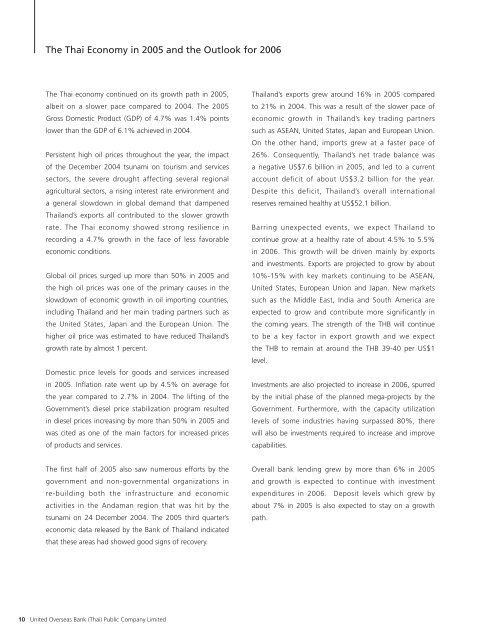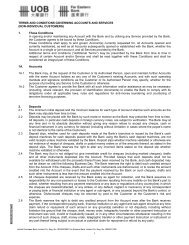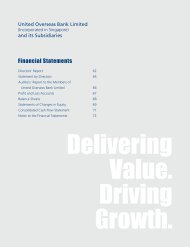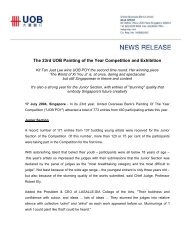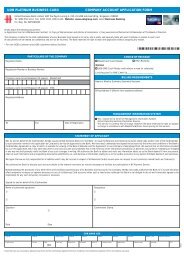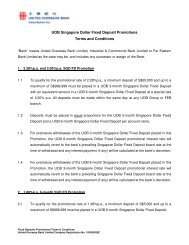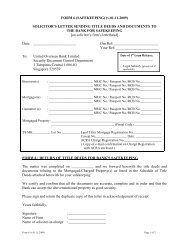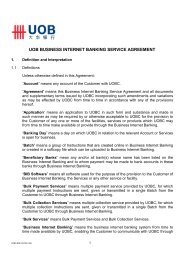(Thai) Annual Report 2005 - United Overseas Bank
(Thai) Annual Report 2005 - United Overseas Bank
(Thai) Annual Report 2005 - United Overseas Bank
Create successful ePaper yourself
Turn your PDF publications into a flip-book with our unique Google optimized e-Paper software.
The <strong>Thai</strong> Economy in <strong>2005</strong> and the Outlook for 2006<br />
The <strong>Thai</strong> economy continued on its growth path in <strong>2005</strong>,<br />
albeit on a slower pace compared to 2004. The <strong>2005</strong><br />
Gross Domestic Product (GDP) of 4.7% was 1.4% points<br />
lower than the GDP of 6.1% achieved in 2004.<br />
Persistent high oil prices throughout the year, the impact<br />
of the December 2004 tsunami on tourism and services<br />
sectors, the severe drought affecting several regional<br />
agricultural sectors, a rising interest rate environment and<br />
a general slowdown in global demand that dampened<br />
<strong>Thai</strong>land’s exports all contributed to the slower growth<br />
rate. The <strong>Thai</strong> economy showed strong resilience in<br />
recording a 4.7% growth in the face of less favorable<br />
economic conditions.<br />
Global oil prices surged up more than 50% in <strong>2005</strong> and<br />
the high oil prices was one of the primary causes in the<br />
slowdown of economic growth in oil importing countries,<br />
including <strong>Thai</strong>land and her main trading partners such as<br />
the <strong>United</strong> States, Japan and the European Union. The<br />
higher oil price was estimated to have reduced <strong>Thai</strong>land’s<br />
growth rate by almost 1 percent.<br />
Domestic price levels for goods and services increased<br />
in <strong>2005</strong>. Inflation rate went up by 4.5% on average for<br />
the year compared to 2.7% in 2004. The lifting of the<br />
Government’s diesel price stabilization program resulted<br />
in diesel prices increasing by more than 50% in <strong>2005</strong> and<br />
was cited as one of the main factors for increased prices<br />
of products and services.<br />
<strong>Thai</strong>land’s exports grew around 16% in <strong>2005</strong> compared<br />
to 21% in 2004. This was a result of the slower pace of<br />
economic growth in <strong>Thai</strong>land’s key trading partners<br />
such as ASEAN, <strong>United</strong> States, Japan and European Union.<br />
On the other hand, imports grew at a faster pace of<br />
26%. Consequently, <strong>Thai</strong>land’s net trade balance was<br />
a negative US$7.6 billion in <strong>2005</strong>, and led to a current<br />
account deficit of about US$3.2 billion for the year.<br />
Despite this deficit, <strong>Thai</strong>land’s overall international<br />
reserves remained healthy at US$52.1 billion.<br />
Barring unexpected events, we expect <strong>Thai</strong>land to<br />
continue grow at a healthy rate of about 4.5% to 5.5%<br />
in 2006. This growth will be driven mainly by exports<br />
and investments. Exports are projected to grow by about<br />
10%-15% with key markets continuing to be ASEAN,<br />
<strong>United</strong> States, European Union and Japan. New markets<br />
such as the Middle East, India and South America are<br />
expected to grow and contribute more significantly in<br />
the coming years. The strength of the THB will continue<br />
to be a key factor in export growth and we expect<br />
the THB to remain at around the THB 39-40 per US$1<br />
level.<br />
Investments are also projected to increase in 2006, spurred<br />
by the initial phase of the planned mega-projects by the<br />
Government. Furthermore, with the capacity utilization<br />
levels of some industries having surpassed 80%, there<br />
will also be investments required to increase and improve<br />
capabilities.<br />
The first half of <strong>2005</strong> also saw numerous efforts by the<br />
government and non-governmental organizations in<br />
re-building both the infrastructure and economic<br />
activities in the Andaman region that was hit by the<br />
tsunami on 24 December 2004. The <strong>2005</strong> third quarter’s<br />
economic data released by the <strong>Bank</strong> of <strong>Thai</strong>land indicated<br />
that these areas had showed good signs of recovery.<br />
Overall bank lending grew by more than 6% in <strong>2005</strong><br />
and growth is expected to continue with investment<br />
expenditures in 2006. Deposit levels which grew by<br />
about 7% in <strong>2005</strong> is also expected to stay on a growth<br />
path.<br />
10 <strong>United</strong> <strong>Overseas</strong> <strong>Bank</strong> (<strong>Thai</strong>) Public Company Limited


